|
Quantum Key Distribution : Theory and Practice
Grace Mupoyi Ntuala (
mupoyi.n.grace@aims-senegal.org)
African
Institute for Mathematical Sciences (AIMS)
Senegal
Supervised by: Dr. Kassem Kalach
k2kalach@uwaterloo.ca
Institute for Quantum Computing
13 June 2015
Submitted in Partial Fulfillment of a Masters II at
AIMS

Abstract
Information security has increasingly been important for
individuals and organizations. For example, secure communications in financial,
commercial and military applications are vital. Cryptography is the science of
all aspects of information security. In particular, public-key cryptography is
necessary to provide secure communications over the Internet.
Unfortunately, based on the assumed difficulty of some
mathematical problems, public-key cryptography (includes ECDSA, ElGamal, and
RSA schemes), would be broken with either advances in algorithms or the advent
of quantum computers. On the other hand, quantum cryptography, based on the
laws of quantum physics, provides perfect security even against the most
general quantum attacks.
Quantum key distribution (QKD), a branch of quantum
cryptography, allows two legitimate parties to expand a previously shared
secret over a public quantum channel. Importantly, eavesdropping can now be
detected, this is impossible in classical cryptography. Although many QKD
protocols have been proposed, they all face technological challenges in
practice, thus making them not suitable in many applications. In this project,
we survey the most promising protocols, and compare them from theoretical and
practical point of view. In particular, we study how and where they can be
practical, and try to propose new applications.
i
Declaration

I, the undersigned, hereby declare that the work contained in
this essay is my original work, and that any work done by others or by myself
previously has been acknowledged and referenced accordingly
Grace Mupoyi Ntuala,
ii
Contents
Abstract i
EPIGRAPHY 1
INTRODUCTION 1
1 Classical Cryptography 2
1.1 Definition 2
1.2 Security concepts 3
1.3 Cryptosystem 3
1.4 Diffie-Hellman Key Exchange 6
1.5 Information Theory 7
2 Fundamentals of Quantum Mechanics 8
2.1 Polarization 8
2.2 Circular polarization 9
2.3 Heisenberg Uncertainty principle 10
2.4 Entanglement 11
2.5 No-cloning Theorem 12
3 QKD protocols 14
3.1 QKD with classical notion 14
3.2 Main operation of key exchange technic of QKD 14
3.3 Assumption and protocol 16
3.4 Protocols Using Heisenberg's 16
3.5 Entaglement base to protocol 18
3.6 Attacks on a QKD channel 19
4 QKD implementation technologies 21
4.1 Sources for QKD 21
4.2 Detectors 23
5 QKD Application 25
5.1 Network 25
5.2 Databases future work 30
CONCLUSION 1
References 4
EPIGRAPHY
1
The best thing is in the thorns
by Jean Kanyinda Bidiku
1
INTRODUCTION
Naturally, human had a desire to communicate secretly since
the beginning of civilization. Many ancient societies Egypt, India, china,
Japan, developped methods of secret communication like globaly a new science
where the goal was to keep with innovations and evolution that science
progressed and Stephen Weisner proposed a new concept of crypthograhy in
conjonction with a quantum mechanics, a subfield of quantum physics, and it was
publish in a seminal paper titled Conjugate coding. But in 1983, with
SIGACT News, Stephen Weisner proposition was eventually
published in that document, he showed how two messages can be stored or
transmited by encoding in two conjugate observable, Using physical notion, such
as linear or circular polarization so that either of which may be recieveed and
decoded. The physical notion cannot use both in the same time.
After SIGACT News published Weisner proposition of quantum
conjugate coding, the field red team of quantum cryptography red was created.
Using Weisner work, there are same peoples based on it 1984, charles H.
Bernnett of the IBM, Thomas J. Watson research center and Gilles Brassard come
up with a concept of secure communication based on conjugate observable. After
six years, an other person proposed a different approach to quantum key
distribution which is based on pecullar quantum correlations known as quantum
entanglement. We may know that after people developped classical crytography
one of the most promising. They wanted to find other way to keep secret message
which will be more secure since RSA crypto-system have a high level of security
with a discrete logarithm, factoring, or Diffie-Hellmann problem, quantum
cryptography come with a QKD to solve this problem and that provide a small
size of key between sender and receiver.
The combination of cryptography and quantum mechanics notions
give this new field a condition to be a power field in terms of security. As
this field used a photon as matter for transmission message and the two notions
of quantum mechanics use in this field have an ability to detect any kinds of
attack in the channel. In general, quantum cryptography have a goal which is to
perform tasks that are impossible with conventional cryptography. Quantum
cryptography has an avantage since the security is based on physical laws such
no-cloning theorem, heisenberg principle. Having those notion which QKD as tool
of quantum cryptography, quantum bit and quantum coin tossing, quantum
cryptography was prove that this cryptography is unconditionally secure.
In our thesis we will talk about Quantum Key Distribution and
we will develop five chapters. In the first chapter we will discuss about
classical cryptography, in second chapter, we will focus on fundamental of
quantum mechanics, in the third we will try to speak about QKD protocols.
Chapter four we will focussed on the different implementations of QKD and in
the last chapter we will talk about QKD applications. At the end of this
thesis, we will propose, as a contribution in this new field of security, a new
application of QKD in Business Intelligence. We hope there will be an outcome
for a new generation of Business Intelligence.
2
1. Classical Cryptography
In this section, we will talk around all notions in
cryptography. Since longtime, in the world to keep secret message was very
important. That trick in mind has been with us since we moved out of caves,
started living in groups and decided to take this civilization idea seriously.
As soon as there were different groups or tribes, the idea that we had to work
against each other surfaced and proliferated, along with rank violence,
secrecy, and crowd manipulation. The earliest forms of cryptography were found
in the cradle of civilization, which comes as no surprise, the regions
currently encompassed by Egypt, Greece and Rome. In Rome when Julius Cesar
Emperor, wanted to send a message through the war to inform his army generals
about something, he was writing a message covertly by shifting the alphabet
letters so that if another person foundn'ta message can not understand what is
going on just the intendedreceiver would knows how to read the message.
1.1 Definition
Cryptography is a word coming from Grec which is divide by two
parts Cryptus which is mean Keep (Secret) and Graphy is
define as written. By those Grec words we define Crytography as a way to keep
secret a message (Written) using some mathematics notions, principaly number
theory. other way, cryptography is a way and techniquess to study how to make
secure information using mathematical notions with concepts such as
confidentiality, data integrity, entity authentication and data origin
authenticate.
1.1.1 Mathmaticaly. We define Cryptography as a
set of five G = (P, C, Ck, Dk, k) where
1. G is our main set of cryptography;
2. P is a the clear message that we want to keep secret;
3. C is a finite set of text blocks can be digit
4. Ck is an encryption function;
5. Dk is a function of decryption;
6. k is the key, that we use to keep secret a
message.
According to [STI06], in order to define just cryptography as
a way to secure message, there is also other words which are related to
Cryptography.
1. Cryptogramme is one way use through the media (newspaper,
magazine, so on) to keep secret a message. Is technic, is based on an
encryption message is just a shifting of letters.
2. Cipher is a secret way to write a message using
subtitution or transposition of letter specially in form of symbol.
3. Cryptanalysis is a science where people analysis a
cryptogram with goal to decrypt a message keep there.
4. Cryptology is science wich combine cryptography and
cryptanalysis.
5.
Section 1.2. Security concepts Page 3
Cryptolect is a secretive language form used by a subculture
dissimiller for a message.
This field is remaind not new for all persons but most of
people use cryptography without knowing that they use this field of science to
keep secret a message, communication whatsoever. Authentification,
confidentiallity, non-repudiation and integrity those are conditions if you
need a good security of message in term of secrecy. These conditions in the
other way is called primitive function, because its make sure the
security of information using some mathematical notions.
1.2 Security concepts
Let's define those concepts:
1. The authentification is a function that ensure
verification that the person who are communicate are still the same people. All
time we are dealing with this function, we are still answer in same important
questions. The answer in those question, make a new functions which are connect
directly in the security system where its make a verification of certification,
control of access, the key manager, proof of knowledge and proof of
disclosure
2. Integrity is a function use for data verification that is
if during the transmission the data stay the same as in the beginning. To do
it, one part must have the ability to detect data manipulation by unauthorized
parties.
3. Non-repudiation, this service in the security of
information, is the most important such that when someone use or send data, the
system registers an action and after, we can verify the information and
reconstruct the scheme of communication so that the person cannot lie the
action he did. It means also the disponibility of information in the system.
4. Confidentiality is a function or service used to verify
the content of information, if there are not modification on it. (goal to keep)
from the persons who are authorized.
Cryptography, science including all security for sharing
datas, use those principals in terms of safety. As we defined a cryptography as
a set G of five elements, to secure a message or to provide the writing to
become unreadable, to apply those concepts in terms of implementation, we use
the most import element which is a key in the set G. To build a good secure
system, we need to compute a good secure key. To build this key, we follow a
mathematics concept of modulo in Z. For that, we have two kind of Keys: a
private and public key. Around those two types, we define what we call
cryptosystem.
1.3 Cryptosystem
In terms of Key, we can define also two kinds of cryptosystems
for the security of data in the society. In both, we will try to say something
about algorithm, keys and mathematic definition if is possible.
1.3.1 Symmetric Cryptosystem. A symmetric
cryptosytem, is called also a private key use same key for encryption and
decryption. In order to get a symmetrics cryptosystem, we must define tree
algorithms, the generator of keys, the encryption and decryption.
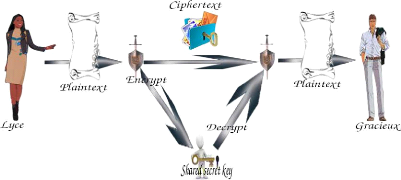
Section 1.3. Cryptosystem Page 4
Figure 1.1: Symmetric Cryptosystem
1.3.2 Keys Generator algorithm. The generator
Keys algorithm produce a key with random l bits. The mathematics
relation is given by:
G(l) = k
.
1.3.3 Encryption Algorithm. Many definition
can be given around the encryption word. As said [MVOV96];The encryption is a
function including e E k such that we can define uniquely a
bijection from P a set of plaintext to C set of cipher and is
denoted by C(p). This algorithm makes cipher of the message with a key
generated by the generator keys algorithm, it is defined by:
C(P) = c.
1.3.4 Decryption algorithm. A function is
called Decryption function if and only if V k E K, ?
Dk a bijection function goes from C to P. This
function as the same to recover the plaintext using the cipher, so the relation
is given by:
Dk(c) = P.
This function can be writing as
Dk(CP) = P.
That is the main way to encrypt and decrypt using symmetrics
cryptosystems. Certaintly, we are talking about security but in all thing,
there are what we call drawback and advantages.
1.3.5 Advantages. In private key
distribution, there exist a restruction to keep secret a key, that key is
shared from one side to the other side with availability to both side, just two
actors in the process can know how it look like. That ensure a communication
channel, this implementation is easy, less complexity for implementation in
hardware.
1.3.6 Drawback. The private key cipher has a
big problem, it is the key management. When we are dueling with this such
cryptosystem, the length of the message is the same as the length of the
cipher. So to generate a key for a person, you may produce a key for each
message that you want to send. When we have an algorithm which makes ciphers
one bit by one bits it is called Stream cipher and other use to
encrypt n bits directly and we call it Block cipher.
Section 1.3. Cryptosystem Page 5
D = Cdmod(N)
1.3.7 Same Private Key Cipher.
1. Block Cipher : The most popular block cipher use for security
are:
(a) DES define by Data Encryption Standard;
(b) IDEA ;
(c) AES define by Advanced Encryption Standard.
2. Examples of Stream Cipher: There are many stream cipher
(a) Pseudo-Vernam or XOR operator. We know that when
we are talking around computing information in computer, the unit is a bit.
That bits in full it means Binary digit is a composition of 0 and
1.
(b) RC4 is ciphering byte by byte.
(c) Vigenere cipher
1.3.8 Asymmetric Cryptosystem. The asymmetric
cryptosystem or the public key cipher is quite different to private cipher. The
public Key distribution as we named it in other word. This algorithm is the
most popular in terms of utilization. The asymmetric cryptosystem includes a
new notion of signature for key verification. Alice will send a message to Bob
using the private Key when Bob will get the message, using same mathematic
operation, he can know immediately if Alice send the message or not. All
private Key have a corresponding public key. By definition, asymmetric
cryptosystem is an algorihm using differents keys to encrypt and decrypt a
message, also you can not derive the decryption key from the encryption key.
According to [STI06], the signature is define as a set quintuplet (P, A, K,
S, V ) verifying: P is a finite set of plaintext; A a
finite set of signatures; K a finite set of Keys such that V k
E K, sigk E S is a verification function corresponding
verk E V . So, the signature function is a map
sigk P -p A,
and the verication function is a map define by:
verk P x A ?p
{True,False},
{Which verify Vx E P and y E A
verk = T rue if y = sig(x); False if y
= sig(x).
Diffie and Hellman at Stanford University achieved an
astounding breakthrough in 1976 by coming up with a method that addressed
symmetric cryptosystem problems and that was radically different from all
previous approaches to cryptography, going back over four millennia [STI06].
1.3.9 Base of RSA algorithm. Diffie-Hellman
came up with the concept of public-key cryptography. One of the first
cryptographic algorithm that meet the requirements for public-key systems was
the RSA algorithm developed by Ron Rivest, Adi Shamir, and Len Adelman. A
typical size of n is 1024 bits, or 309 decimal digits. Thus, the
plaintext is encrypted in blocks, with each block having a binary value less
than some number n. That is, the block size must be less than or equal
to log2(n); in practice, the block size is k bits,
where 2k< n
<2k+1. The encryption and decryption for
public Key algorithm are given by modulo operation.
C =
Memod(N).
This is an encryption function and
Section 1.4. Diffie-Hellman Key Exchange Page 6
Figure 1.2: ASymmetric Cryptosystem
is the decryption function. The Key generator: The key
generator is the most important for RSA security. It is the generator of
private key and public keys.
? p,q ? Z, ? N such that N = pq,
1.4 Diffie-Hellman Key Exchange
Diffie-Hellman is the first asymmetric encryption algorithm,
invented in 1976, using discrete logarithms in a finite field. It allows two
users to exchange a secret key over an insecure medium without any prior
secrets. This Public-Key is based on the discrete logarithm in finite field
which is hard to solve. In general, we consider a Diffie-Hillman protocol
secure when an appropriate mathematical group is used.
Diffie-hellman key-exchange is a way that two persons agree
about a number without the third person knows the number. This method is the
same quite than Elgamal public-key encryption because the security is based on
discrete logarithme and Diffie-Hellman problem [Mer07]. This key-Exchange
methode use a group notion denoted by G. Diffie-Hellman the choose
number by Alice and Bob still secret Eve in classical scheme can be in the
middle understand the communication, she couldn't know the secrete number. The
Diffie-Hellman is define also as (DHP) given a prime p, a generator
g of Z* p and element ga mod (p) and gb
mod (p),find gabmod(p). We need to find a
generator
1. Alice and Bob will choose the finite group where they will
play the security game and generate a generator
2. Alice will choose randomly a number and compute
ga
3. Bob must do the same thing than Alice but will choose
b as a natural number and compute gb
4. Alice will compute (gb)a
Section 1.5. Information Theory Page 7
5. Bob, he will compute (ga)b
For the Diffie-Hellmann protocole, the secret values of Alice
and Bob, a and b, must be big numbers. There are steps for
encryption which Alice and Bob will follow if they want to share secret
messages without Eavesdropper knows.
Note: The computation must be difficult from Alice to solve
Bob's private key and from Bob to solve Alice's private key. If the computation
is easy, that allows Eve simply to substitute her own private, public key pair,
plug Bob's public key into her private key, produce a fake shared secret key,
and share it in both sides.
1.5 Information Theory
In our century, the information is still in order the most
important in all part of life (societies, entreprises, millitaries) and there
are some assumption which expect that if you know to manipulate an information
you can do many things. So, people developped a concept in information named
Information theory. The principal actor for this theory is nammed
Claude Shannon who in 1949 published a article with a title
»Communication Theory of Secrecy Systems» in the bell
System newspaper that made a big influence in cryptography science. With
Shannon theory, we are now able to make a quantification of our information.
8
2. Fundamentals of Quantum Mechanics
Classical physics failed to explain phenomenon such as the
black body radiation and presence of spectral lines in the spectrum of
absorption and emission of some atoms. A new theory known as quantum mechanics
arised in the 20th century and gave a satisfactory
explanation of those phenomenon. A conceptual difference between this new
theory and classical mechanics is the desapperences of the full description of
the trajectory of a particle. Indeed, in quantum mechanics, one speaks of the
probability of the particle to be at a certain position at a given time.
Quantum mechanics is a physical theory that discribes some systems where h
is not negligible anymore. It is especially efficient to describe physical
phenomena at molecular scales and above (except at high energies such that
solar energy. We need to take into account relativistic effects). We will
recall the five postulat of quantum mechanics
1. The knowledge of state of quantum system is completely
known in normalizable vector of a hilbert space H usually denoted |?(t)i;
2. The correspondance principle: to any physical observable
corresponds an hermitian operator which acts on the vectors of a hilbert
space;
3. If we have a initial state ái, the
probability that it is at the final state áf is given by
Páf =
|háf|áii|2, (2.0.1)
If the system is in the state á, the mean value of the
measure of an observable is given by
h àAi = há|
àA|ái. (2.0.2)
4. Projection of quantum states Let an be
an eigenvalue of an operator A and is the output of measurement at time t and
let ö be its associated eigenstate. The state of the system after the
measure is projected on the eigenspace associated to an.
5. Time evolution of state öt is given by the
schrödinger equation
in ? ?t|ö, ti =
àH|ö,ti. (2.0.3)
One notices that H is the generator of time translation and is
called the hamiltonian is the
operator is associated to the energy of the system and the
hermitian have a dimension tw.
2.1 Polarization
First, we will present the polarization of a classical
electromagnetic field and translate it in the frame of quantum mechanics.
According to Maxwell's equations in the vacum, we observed that light is a
transverse electromagnetic wave which means that the electromagnetic field is
perpendicular to the direction of propagation of the wave. To simplify, we will
consider a monocromatic wave which propagates along the z-axis :
E~ = ~Eocos(ùt - kz + ?),
(2.1.1)
Section 2.2. Circular polarization Page 9
Ex =
Eo v2coswt; (2.2.1)
2r
where w is a vibration frequency,
|Eo| is the amplitude, k is the wave vector given
by k = À , and À
is the wavelenght. The vibration frequency is given with the
relation
w = c x k, (2.1.2)
here c is the speed of light and ? is the phase at the
origine. The electomagnetic field is polarized in the plane perpendicular to
the direction of propagation thus we let z = 0.
2.1.1 Linear polarization. In the linear
polarization, the electric field describe a straight line in a single direction
which is the direction of propagation. The mathematical relation is given
by:
Ex = E0cosOcoswt, (2.1.3)
Ey = E0sinOcoswt. (2.1.4)
With Malus law, in the output of the polarization, the electric
field is proportionnal to the square of the intensity.
I' = Icos2(O -
á). (2.1.5)
If O = á - ð 2 that imply
in the output of the analyzer, we will not get any light.
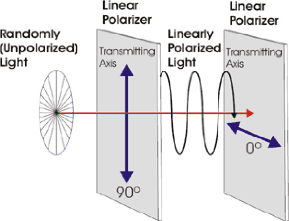
Figure 2.1: Linear polarization
The orientation of a linearly polarized electromagnetic wave
is defined by the direction of the electric field vector
2.2 Circular polarization
The second polarization is circular, when the electric field
describes a circle in the plane during the propagation of the wave along
z. The wave is polarized circularly if
Section 2.3. Heisenberg Uncertainty principle Page 10
Eo
Ey =
Section 2.4. Entanglement Page 11
v2 sinùt. (2.2.2)
This is a general cas of polarization, where the polarization of
electromagnetic radiation such that the
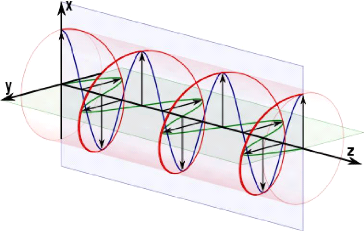
Figure 2.2: Circular polarization
tip of the electric field vector describes an ellipse in any
fixed plane intersecting, and normal to the direction of propagation. The
mathematical definition is
ÇA cos ùt )
Ê= ;
B sin ùt
with A =6 B and A, B =6 0. satisfy
to
ÇX )2 ÇY )2
+ = 1. (2.2.3)
A B
2.3 Heisenberg Uncertainty principle
People are interrested in quantum mechanics such that they
made many research, experiences and found new concepts which clarify the theory
of quantum. In 1927, Werner Heisenberg discovered Heisenberg Uncertainty
Principle. Quantum system is a system which calls mesure, hermitian operators,
and observable, as define previously. Quantum mechanics is applied to the
microscopic domain of particle and its the principle for complementarity
[NAZ02] of two states, momentum and position. In general, Heisenberg
Uncertainty Principle is given by any hermitian operators denoted by x
and p, where x describes the position and p the
momentum of particle in certain coordonate. This principle simutaneously
increase the position and the momentum, it is impossible to measure a position
without disturbing momentum, and vice versa. This principle can be called a
principle of complementarity [NAZ02]; when the momentum is increased, the
position decreases and when the position increase the
momentun decreass (distribution is proportionnal). In general,
the Heisenberg Uncertainty Principle is given by the following formula:
~
ÄxÄpx = 2.
(2.3.1)
Note that Ä symbol is what we call Uncertainty.
The uncertainty principle is taken as a limitation of quantum preparation
(states)[BHL07]. There are many application on it such that in signal
processing with Fourrier transformation but the one domain that is interesting
to us is cryptography. We will see how this notion is applied in cryptography.
In this figure the uncertainty momentum is given by Äv is
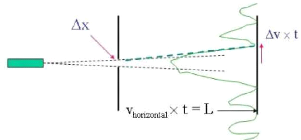
Figure 2.3: Heisenberg Uncertainty Principle
still the same as Äp.
2.4 Entanglement
We describe that quantum mechanics include states but those
states are characterized in two [Sar], pure and mixed state which are
define by any linear operator acting on H called density
operator, satisfies the following properties:
1. ñ is define positive ñ 0;
2. tr(ñ) = 1
For the following conditions, we describe other conditions for
a state. Pure state are define when ñ2 =
ñ and ñ2 > ñ. i.e
when we have a pure state we have always an unique state vector. In the hilbert
space it is expressed as a projection operator on |ø). For the
mixed state, the definition is quite different than the pure state. The mixed
state is a combination of pure states. Entanglement notion is defined as an
inseparable state in quantum mechanics, it can be taken as two states which are
commited that means [A,B] = 0. In more details, let's consider
corresponding Hilbert spaces on the state A and B where we write respectively
HA and HB. The composite system is a product
HA®HB. If the first can be represented by
|ø)A and the second by |ø)B,
the product is given by |ø)A ®
|ø)B. Those states in binary notation will take
|ø)A = {|0)A, |1)A} and
|ø)B = {|0)B, |1)B}, thus
the basical representation
Section 2.5. No-cloning Theorem Page 12
of entanglement using binary representation is:
v2
1
v2
1 (|0iA|0iB + |1iA|1iB); (2.4.1)
(|0iA|0iB - |1iA|1iB). (2.4.2)
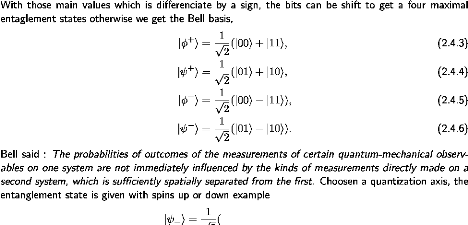
)
| ?i|?i - |?i|?i
(2.4.7)
The quantization notation is what we will use more in the next
point where we will go through and more details in quantum protocols.
2.5 No-cloning Theorem
With those main values which is differenciate by a sign, the bits
can be shift to get a four maximal
entaglement states otherwise we get the Bell basis,
1
|ö+i = v2(|00i + |11i, (2.4.3)
1
|ø+i = v2(|01i + |10i, (2.4.4)
1
|ö-i = v2(|00i - |11i), (2.4.5)
1
|ø-i = v2(|01i - |10i). (2.4.6)
Bell said : The
probabilities of outcomes of the measurements of certain quantum-mechanical
observables on one system are not immediately influenced by the kinds of
measurements directly made on a second system, which is sufficiently spatially
separated from the first. Choosen a quantization axis, the entanglement state
is given with spins up or down example
1
|ø-i =
v2(
Having a classical information, we can share it to differents
entities without any problem. We can duplicate the information. But in quantum
information such operation seems quite impossible. In 1982, Wootters, Zurek and
Deiks stated a no-cloning theorem which profound an implication in quantum
computing and its related field [NAZ02] of quantum cryptography. With a quantum
state choosen from a given set of possible states can be cloned perfectly only
if the states in the set that are mutually orthogonal. But if a set of states
is orthogonal, the states are related to each other in the same way that
classical alternatives are related to each other. There is none of the
ambiguity that typically charactarizes the relation among quantum states. This
is what we meant when we said cloning is possible only if the information being
cloned is essentially classical. More explaination can be found [NAZ02]
2.5.1 Characteristics of no-cloning theorem.
After many experience, the following characteristics come up to make a
point in the security of the message without using a error
/The no-cloning theorem use to prevents using a classical
error technic on quantum states.(Enable to create a backup copies of states
)
/The quantum measurement is impossible. That means the state
in quantum area can not be diplucate. /The no-cloning theorem does not prevent
superluminal communication via quantum entanglement, as cloning is a sufficient
condition for such communication, but not a necessary one.
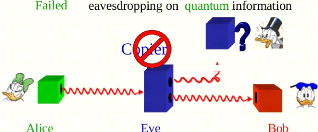
Section 2.5. No-cloning Theorem Page 13
Figure 2.4: No-cloning
14
3. QKD protocols
QKD in short mean Quantum Key Distribution was
invented by Bernett and Brassard in 1984,
this innovation was recognized as a main key-technology for our century. There
are many questions which are still asked like you can see in the publication of
[SRS12]. QKD use same classical notions learnt from public-key cryptosystem
such as management of keys and their creation, the activation, assignment,
building (to identities), escrow, as well revocation and destruction. The
experiment of QKD did with people and organisation, like work of Tanaka et
al. in 2008. It shows that the randomness for QKD keys still a vital
security of subsequent applications based on these keys. Till now, this field
has many questions which brings innovations in security science. In this
section, we will try to focus our mind in QKD protocols, give details relate to
the basis of each protocols. As we showed it previously, such technic requires
a knowledge in quantum mechanic, particularly in light.
3.1 QKD with classical notion
That QKD is a new tool in the toolbox of cryptographers, does
not excludes classical notion for security concepts as defined in other
section. To share data, informations or messages using QKD, we need to use
cipher; most of the times the QKD network uses One-time-Pade1
cipher. For interaction between different parties, we may need to establish
three mains phases to secure communication; this is deeply explained in the
litterature of [SML10]
1. Key agreement : This phase is about the agreement of sharing
private key between parties
2. Authentification : Second phase is to be sure that the
message received comes from a particular party to avoid the attack of
man-in-the middle2
3. Key usage : Once the key security is etablished, it can be
used for encryption, further authentification or other cryptographic
proposes
Every day cryptography is improving. People come up with new
tools; after discovering a problem in one cryptosystem, they want to improve
that and the cryptography system base on public-key, which is more
used in the community, are retooled with new and standards algorithms over the
coming years. That give a big opportunity to incorporate QKD as a new tool
offering fundamentally new security features. QKD is based in quantum mechanics
notion, it provides two kinds of protocols which use Heisenberg Uncertainty
Principal and quantum Entanglement.
3.2 Main operation of key exchange technic of QKD
Based on Vernam code, this cipher required the use of key
which provide only authorized parties suppose to know and the key are renewed
this is an idea of the rapport of [KDB+]. All QKD have two phases
1One-time-pade is a crypto-system where the key is
used once for sharing data
2Man-in-the middle : Its the attack of Eavesdropper
when she is placed in the middle of the channel and when the transmission of
message come, she will take it decrypt and send it to Bob without Bob knowing
that the message was decrypted and when Bob will reply to Alice she will do the
same

Section 3.2. Main operation of key exchange technic of QKD Page
15
Figure 3.1: Key distribution in conventional cryptography
1. Firstly, Alice will send to Bob a signals 3 to
measure.
2. Secondly, Alice and Bob will deliver to check the result of
measure4
For this two phases, QKD use two channels one for quantum
signal build with optical fiber and the classical channel for classical
communication which is public. The above figure explain the principe of
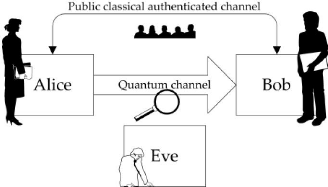
Figure 3.2: Principe of QKD
QKD. In the next point, we will talk about which kind of QKD
can be found in practice. There exist two kinds of QKD based in quantum
mechanics notions which are HUP5 and the Entanglement.
3The signals that we are talking is quantum (other
talk instead of quantum they use soap bubble) 4To check the result
of measurement, they use the classical way
5Heisenberg Uncertainty principle
Section 3.3. Assumption and protocol Page 16
3.3 Assumption and protocol
Untill now the research considered a QKD as the only one key
exchange which is secure. After their experience and verification, they came up
with same characteristics to show us that this system stayed a secure system
and the eternel system secure. Let us enumerate them.
1. This system give an guarantee to detect the Eve presence in
the channel;
2. The key is absolutely secure that does not depend to the
complexity of the algorithm or the technology used by Eavesdropper to
attack.
Having those assumptions with a properties of quantum
mechanics, quantum cryptography provide two kinds of protocols. All the
protocols are able to detect the Eavesdropper in the channel and have the
unconditional security.
3.4 Protocols Using Heisenberg's
There are many protocols using this notion of HUP but for us,
we will focus on those which are more used and discovered before. We may have
in mind that all the protocols follow the same structure6.
Prepare and send protocol
After Weisberg publish a paper where he introduced the concept
of quantum mechanics in communication, Bernett and Bassard in 1984 come up with
a new revolutionnary idea which was the first proposal of QKD protocol using
totaly HUP (based on quantum properties) notion. This protocol is the oldest
for quantum cryptography, based on basis7 which are quite related to
the polarization notion. We have the rectilinear and the diagonal basis for
BB84. Quantum protocol can be describe in two steps or phases, quantum and
classical one. Let us describe firstly quantum phase and classical phase
after.
Quantum phase
Any message passing through in the computer are converted into
zeroes and ones which are the informatic unity in classical information theory.
In BB84, there exist a correspondant unity for quantum information to express
information. Using Dirac notation, we express the information unity with a
braket as |øi, |1i or |xi and its call qubits 8.
Other definition, we call a qubit a superposition of zeroes and ones
(|00i, |01i, |10i) , is described by complex number with an
argument 1 belong the set
{á|0i + /3|1i : |á|2 + |/3|2
= 1;á,/3 ? C}, (3.4.1)
we take |0i and |1i as two references qubits, corresponding to
two orthogonal states in a quantum system.
6Structure means the fonctionnality is the same but
few differents we can find but in general is the same
7BB84 is the main protocol and the remaind follow
the way that its works the difference is few certain have a difference just in
basis used to send the information
8Quantum bits
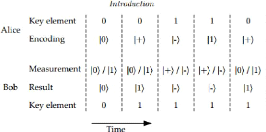
Section 3.4. Protocols Using Heisenberg's Page 17
Figure 3.3: Transmission photon by Alice to Bob
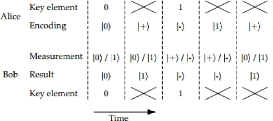
Figure 3.4: Detection of photon by Bob using states
measurement
1. In BB84, Alice sends a sequence of photon to Bob, each
independantly choose one of the four polarization (the four polarization are
vertical, horizontal, 45% and 135% you can have an idea checking the figure
down).
2. For each polarization, Bob will choose one base for
measurement to achieve the result
3. Bob will records the result and his measurement bases and
after, he will publicly acknowledges his receipt other signal.
Classical phase
In this phase the entities have a following steps
1. Alice broadcasts her bases of measurement, Bob broadcasts his
bases of measurements
2. Alice and Bob discard all events where they use different
bases for a signal
3. To test for tempering, Alice randomly choose a fraction,
if all remaining events as test events, she publicly broadcasts their position
and polarization
4. Bob broadcasts the polarizations of the test events
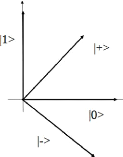
Section 3.5. Entaglement base to protocol Page 18
Figure 3.5: Data transmit between two parties using basis
5. Alice and Bob compute the error rate of the test events.
If the compution of error rate is large than some prescribed threshold value,
say 11% they about otherwise, they proceed to the next step (This step is where
Alice and Bob detect Eve presence)
6. Alice and Bob each convert the polarization data of all
remaining data into a binary string called a raw key. They can perform
classical post-procesing such as error correction and privacy amplification to
generate a final key.
With quantum mechanics properties, the security is a
efficiency and the Eavesdropper can use any method of attack Alice and Bob will
detect her. The work of [Zha09] explain other notion for the efficiency
security.
3.4.1 B92 protocol . This protocol is a
derivative of BB84 protocol. It was proposed by Charles Bernett in
1992. B92 have the same function then BB84 but the difference is just the half
part of fonctionality from BB84. The encoding of one state for example
|ø) composed by {|0), |1)} we can encode each element of the set in this
way the first element in the set will be encode with rectilinear basis which is
correspond to 0o and |1) encode in diagonal basis this according to
[Hai14]. There exist also other variants QKD protocols using the notion of
Heisenber Uncertainty Principale as you can see in many book where they are
talking about QKD like [Hai14]. We can enumerate other protocols using
Heisenberg like, Six-State Protoco(SSP) proposed by Posquinucci,
Gusin in 1999 the different with BB84 instand of two state and here the
use one.
3.5 Entaglement base to protocol
The protocol using entanglement are called
entanglement-based protocols, Ekert protocols or EPR protocols. This
protocols was discovered by Arthur Ekert at 1991. EPR protocols use
pairs of photons which are entangled. The pairs photons entangled can be
produced by both Alice and Bob or other person. The main idea for E91, is to
use three possible states and testing no violability of Bell inequality that to
detect the evesdropper in the channel. The entanglement protocol follows three
steps:
1. The imposibility for Alice to preduct which polarization she
will get as a result;
2.
Section 3.6. Attacks on a QKD channel Page 19
Secondly, If Alice and Bob carry out polarization of measurement
they will not have a perfect correlated answers but same will be correlated;
3. Last is the Eavesdropper will be detect for every tentative
by Bob and Alice.

Figure 3.6: QKD entanglement protocol
We may need to mention that as quantum cryptography is dueling
with light (photon), the transmission of informations between terminals using
QKD for security implies appropriate devices for connexion. So, the
transmission in this field is done by a channel call quantum channel
and is composed by optical fiber. When Arthur Ekert proposed the
protocol, he based the assumption that Alice and Bob can test the Bell's
inequality by verifying the entanglement of particle. This assumption allows
that the generation of is secure key still possible as long as the entanglement
is verified. This part have more explanation in [QQL10a]
3.6 Attacks on a QKD channel
Since we said that quantum cryptography have a sure security,
that did not avoid in mind of people to find a way to attack. In classical
cryptography, we can mention attacks like brute force, frequency there are many
attacks. Is still the same for quantum cryptography, people developed some
attacks concepts but till now quantum cryptography is still not crackable. Let
us list some attacks used.
1. Individual attack : This attack as you can guess by the
name, is an attack acting in each qubit in the channel. The systems for this
attack are prepared separately (independantly). An example for this attack is
an intercept - resend;
2. The collective attacks : The difference from the first one
is to perform Eavesdropper result. That will joint a measurement to get more
information
3. Coherent attack : This attack one of the powerfull attack
that Eve can use because it has all possible things that she can do. Here, she
has to do an albitrairy preparation of joint state (entanglement) where the
interaction of each qubit must be before the measure being joint in the
channel.
The figures below will describe a little bit the explanation of
each attack for QKD.
Section 3.6. Attacks on a QKD channel
Page 20
Eve individuel Mea urerneal
Bob

A1iaa
Ere AeciI
Figure 3.7: Indivivual Attack
Light Moe
·
Alice
Source
Eve Cal led we Measuremeal

Big Aael1lie
J
Figure 3.9: Cohence attack
Figure 3.8: Collectif attack

Light Plc
·
Eve Collective Mesiuirrrnc ll
ars'
Alice
Some
Bob
Manor
Eve Collrcti.ve Ancitie
21
4. QKD implementation technologies
Implementation is a way to express an idea. Classically all
ideas along communication are protocols. There are softwares built for
interchange of messages and there exist many protocols which have dif-ferents
functions. To build such software, is what we call implementation. We named
protocols like : http, Smtp, ftp. In quantum, we
described the implementation of BB84 which is privilegie protocol composed by
two sets of non-orthogonal basis and four polarizations. The security of
protocols in quantum cryptography depend on the production of single photon.
There is an art for implementing a new technology with QKD. We will need same
notions like the notions of single photon EPR1 photon source and
photon stabilized interferometer. Those notions are so important for the
implementation of QKD technologies. Quantum technology allows us to organise
and control the components of a complex system governed by the laws of quantum
physics. We have two imperatives driving quantum technology:
1. Technological innovation of miniaturisation,
2. Performance over the classical framework.
Since many years, human did act with matter, they could
explain many phenomenon like periodic table, atoms but they were not be able to
manipulate the behavior of semiconductors. In the second, we see the
implication of human. There are appropriate tools for QKD like sources and
detectors are the mains tools for implementing the QKD technology.
4.1 Sources for QKD
There exist many sources for a QKD. That sources correspond to
the technologies that you want to implement.
1. Single photon : This is a main element for implementation,
the photons have been used in some other fields like quantum optics and quantum
communications. People did experience to perfect a photon applying a single
photon for those subfield of quantum. Photon-gun which is a single-photon, is a
unique photon sources. This elements is given significative progress achieved
in the last decade. In term of emitting information, the number of photons
prove to precise certain number of matters for transmission. There are some
experiments that allows application of laser but indeed, the laser cannot
produce photon number states because the implementation source for a QKD need a
special kind of photon. It is why we are talking about single-photon, that must
have a precise number of photons. This can be understood as follows: the gain
medium of a conventional laser contains a large number of individual atoms or
molecules and each of them has a certain probability to emit a photon during a
fixed time period as said in [QQL10a]. It was found that a single-photon
include atoms or ion gas phase, organic molecules, colour center in crystals,
semiconductor, nanocrystals, quantum dots.
2. EPR photon pair : For this source, the main problem is the
efficent production of photon. The use of entanglement photon pair allow
optical processes and the production of photon pairs need
1EPR : Ekert Protocol
Section 4.1. Sources for QKD Page 22
a spontaneous parametric down-conversion (SPDC). The
conversations of energy and momentum imply that the generated daughter photons
are entangled in spectral and spatial domains. The production of photon pair
here, have two steps using the main toll which is non-linear crystal. Let's see
how its look like the production of photon pair by the figure below.
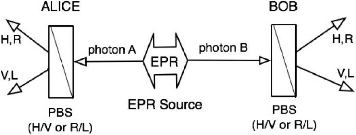
Figure 4.1: EPR source
(a) Firstly, the first crystal can be selected to phase match
vertical pump photon with horizontal down-converted photon pair
(b) Secondly, the second one will be chosen to phase match
horizontal pump down-converted photon pair
The two crystals will be done with 45 % that to get a high
quality of polarization entangle.
3. Attenuated Laser This source, is where Eavesdrpper use same
probability notion to get the information in the quantum channel. The
difference between the first source is the use of linear relation also, we stay
using single-photon. Laser is used as an attack for Eavesdropper. To produce
single-photon for high quality, this model of source have certains probability
to get non-zero probability to get more or than one photon. This experience did
by people is called photon number Splitting
(PNS) attack. The
functionnality of this attack can be describe well in the article of [QQL10b].
It can be detected by testing quantum channel during QKD process.
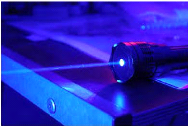
Figure 4.2: Laser source
Section 4.2. Detectors Page 23
4.2 Detectors
[QQL10b] The quantum channel is so powerfull, that it avoid
all attempt for eavesdropping including error in that channel, error are
related in noises for that, in our point, we will present two technologies for
quantum states detection for a QKD system.
1. Single photon detector :
We know that there exist many protocols for a QKD but for us,
we will try to take one of them which will be BB84 one of the usual protocol
used for experiment. Detectors need main elements like a single-photon detector
(SPD), photomultiplier tube (PMT) and more recently they add a new device
called superconductive single-photon detector (SSPD) for a high
performance of detection. This detector follow
(a) Receiving an incoming photon, the SPD have a efficiency
probability for detection which its determined by intrinsic quantum and
coupling losses of the detector.
(b) Dark counts are detection events registered by a SPD while
no actual photon hits it. Due to its random, the QBER contributed by dark count
event 50%.
(c) The registers of photon have an operation in the detector b,
the dead time of the single-photon sending by Alice.
(d) The detector have an output action due to the electrical
pulse in time domain. This action is fructuation of a SPD.
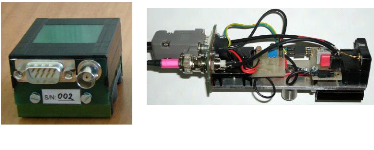
Figure 4.3: SPD
Figure 4.4: SPD detector composition
2. The Optical homodyne detector :
This detector used in the implementation of GMCS2
QKD protcol, there is not a difference with the classical coherent
communication system. The detector here act as follow.
(a) When the sender encode information using one of the
subfield of quantum (As this is about light);
(b) The receiver will recover the complete information;
(c) The receiver will interfering the signal with a local
oscillator;
To discover that Eve attack's, we focus on one basical
requirement of homodyne detector which is limited shot noise in the quantum
scheme. This requirement call a strong local oscillator. This
2GMCS is a one QKD protocol which mean
Gaussian-Modulated Coherent States
Section 4.2. Detectors Page 24
detector compare to SPD, the optical homodyne have a higher
efficiency and a larger bandwidth and a strong local oscillator for production
of interference. Those differences enumerated are big enough to detect in the
high speed photo diode. We must know that the detection efficiency is a
function of the wavelenght of the incoming and to build homody, we have same
challenges for implemantation in QKD.
The first challenge is to find stability of signal and local
oscillator between Alice and Bob that are from the same laser and that will
propagate through the same optical fiber. Secondly, as we said in the beginning
of this points and mention the use of GMCS QKD protocol, the balance detection
scheme is commonly employed to remove the DC background.
25
5. QKD Application
We have seen the importance of quantum cryptography and the
tools related to that field. Now, we reach the point where we will describe two
main points: the first point is on QKD applications in network and the second
point is related to databases; particularly Business Intelligence
(datawerouse). In the last section of this chapter, we will try to propose a
new application of QKD, which is to combine a data warehouse with a QKD.
5.1 Network
We know that to share information between two entities, we
need connexion and for that, there existe same models which were build by
people and published after second world war by ARPA-NET project. That project
was a PETENGONE project in second world war it was impossible for them
to share or contact other bases for sharing data so the upcome of network idea.
A network by definition is a group of two or more computers (Equipments)
systems linked together..
A network follow a model and that model allows an implication
of several steps which are called layers. Let us talk little bit about
the composition of layer.
5.1.1 Model. In network, there exist two
kinds of models that according to the convention of IEEE1,
The OSI and TCP/IP model. The OSI model is composed by seven layers
and TCP/IP is composed with four layers. For our part QKD, we will be more
interest in OSI model and try to explain how the QKD was implemented in the OSI
model and how its works in this model also were precisely researchers
implemented in classical model to become a quantum model. You can see in the
figures how the models look like.

Figure 5.1: Network Model
5.1.2 Integration of QKD in the OSI model layers.
In the begining of 21st century, people used the genius
idea to implement a QKD in the OSI model and this implementation was focus in
some types of layers. The layers where QKD was implemented are session layer,
network layer and the data link loyer. Those layers seem are more important.
The combination of QKD with other protocols in OSI model, is
for an efficiency related to quantum field.
1IEEE (Institute of Electrical and Electronics
Engineers) is a organisation where all networks conventions are approved
Section 5.1. Network Page 26
Section 5.1. Network Page 27
We have a combination with a TLS/SSL in the session layer, in
the network layer where more result are related to the connexion, the QKD find
a cohabitation with an IPSEC protocol, the combination gives a new kind of
protocol called SEQKEIP and the last layer, we have a Q3P is
the mixage of QKD with PPP protocol.
Implementing a QKD in OSI model, give an explanation that the
QKD network technology might be an essential part of modern security schemes
for high performance distributed computing application. This implementation of
secure scheme in OSI model was a project funded F6 called SECOQC which
is a global network and the meaning is given by Secure Communication based
on Quantum Cryptography. This project was developped by BBN
technology, DARPA, researchers of Harvard University, Boston University in
2014. The combination give us the sophisticated protocol and QKD network
architecture.
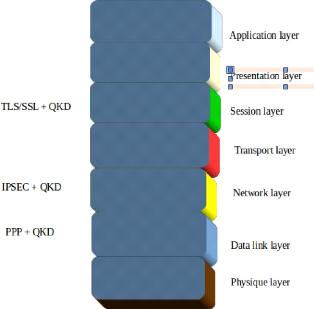
Figure 5.2: QKD implementation in OSI model
There exist a system which coordonate various network tools
such that standard, open, general proposed protocols all those compose a system
architecture and the system is called a grid. Grid computing is
emerging as a modern technology to fulfill the high performance. Computing
requirement of users, institutions and business organization world wide that
was clear in [KX]
5.1.3 Functionality. In this point, we used a
paper of [EAA]. The example take, is the integration of QKD in TLS/SSL for
secure a transaction. That is related with online-commerce and palpaye
classically, we have a secure server and protocol Htpps, the connection use
TLS/SSL mode.
/This protocol ensure a integrity of the message and the
encryption using point-to-point connection
between client and server. The combination of TLS/SSL with QKD
is called QSSL and can be described as two principal modes. The first
modes is about authentification of two sides which are communicating, that
communication is in QKD.
The client and server after authentification, the following
main operation continue to complete the generation of key size negociation and
in the end of the operation of generating key size, the change-cipher-spec and
finished messages can be exchanged.
The second method called the handshaking this method
is a pre-shared keys initialization based on the previous model-1, the
transactions (messages) are inserted before the transmission of
change-cipher-spec and finished message.
The protocol QSSL has been added in the SSL record protocol.
For this quantum cryptography with a principal toll QKD, can be integrated
within SSL/TLS. In SSL, we have an additional parameter which is the Alert
Protocol. Let us describe the fields than the messages follow in quantum
cryptography and the fields can be represented in table where we will
summarise
1. Describe the message use in public exchange phase of the QKD
protocol with a type of 2 bytes
2. Specification of QKD protocol used type 1 bytes
3. Allows the use of more than one version of certain QKD
protocol version 1 byte
4. length (4 bytes) the length of the messages is in bytes.
5. Jo. no 2 bytes QSSL session all operation multiple QKD
protocol instance belong on it.
6. Authentification 1 bytes : specification of the message
whether is authentificated. The idea of this point was taken in the article
[EAA]
|
Type
|
Protocol
|
Version
|
|
Length
|
|
|
Job no
|
Authentication
|
Encoding
|
|
Content
|
|
|
Tag
|
|
/The integration of QKD in network layers. The network layer
is important because in this layer, when we want to ensure a point-to-point
connection between two distinct people and to determine a data travel, the
layer has a capacity to find the short way and quick one using some parameters
for the reach the destinator. There are the most important job for this layer
in OSI model and for the communication. The OSI model use what we call
IPSEC2 with a comming of QKD in 2003, BBN
technologies found a way to integrate a QKD with the IPSEC protocol and
that combination give the another current protocol named
SEQKEIP3.
The new protocol which act with a main toll of quantum
cryptography, has one idea in this construction and the idea is to stick, to
traditional IPSEC and ISAKMP4. Those protocols, you can have some
deep information like how its works in web site of RFC 2409, this is what we
called norm RFC. QKD with
2Internet Protocol security
3Secure Quantum Key Exchange Internet Protocol
4Internet Security Association and Key Management
Protocol
Section 5.1. Network Page 28
IPSEC gives a SEQKEIP, to build simply, we have to define two
phases of Internet Key Exchange and that its the same as the use of ISAKMP
mechanics, that takes an advantage to QKD in order to build a pratical
protocol.
SEQKEIP have three mains in functionnality or phases: phase 1
is the negociation of the ISAKMP SA, phase 2 is negociation of SA and the last
is phase 0, in this Alice and Bob will share the first secret key as adding in
the phase. SEQKEIP have three modes, Quantum mode, Main mode, Quick
mode. All those modes correspond to the phases listed in top. Quantum mode
include quantum cryptography with a key exchange in phase 0, during the
negociation phase of IASKMP SA, we can assimilate this phase to main mode and
when we have the negociation of SA, the corresponding relation in SEQKEIP is
the quick mode.
We can now explain how SEQKEIP works. We will see in the next
figure, the action are numerated.
1. The fixation parameters of our protocol, that will be done
with ISAKAMP SA and SA in other way is the combination of main mode and quick
mode.
2. The implication of QKD using key Exchange with or either
one-time-pad function
3. In last part, is the use of traductional symmetric
cryptography algorithms for exchange of data.
We must put in mind that this operation, the lifetime of
session key is so very short. Its equal to the time need to exchange the secret
key using quantum cryptography. Whitout QKD, IPSEC work in the same manner. The
idea of the quantum cryptography is to sift completely to the unconditional
security function (QKD and OTP). You can find many explanation on [STH]
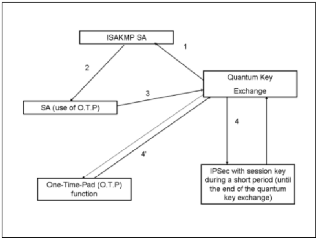
/Integration of QKD in data link : The data link provide the
physical address service to the upper layer and is the only one add a queue to
ensure the validation of data. This layer provide physical adress
Figure 5.3: SEQKEIP functionality
Section 5.1. Network Page 29
which is MAC address to the equipment. In classical part of
network, the protocol used in this layer is PPP5 adding in this a
quantum notion, we will leave a classical communication and will reach quantum
networking. The combiation of PPP with QKD that provide a new protocol call
Q3P.
The integratin of QKD in data link, provide some steps to
achieve the right information. The steps that we list in this part we get
inspiration in the writing of [EAA]. Let us illustrate brievely which steps for
Q3P :
1. In this first step, we have an action of dead, establish,
authentification. The three actions are identical to PPP, that mean the first
phase pass through 3. The negociation of Encryption start just after the
authentification operation for two nodes and the parameters are negociated
also
2. The second phase is if the encryption key functions
successfull, the requirement, the QKD phase will directly start. The encryption
negociation is along the Key length and the TTL6 by sending a proper
ECP7 packet
3. The quantum cryptography exchange will start directly with
one goal to share a secret key in both nodes, that the goal of QKD. The
encryption algorithm will be shared and the TTL of the key. The key that we get
will be used in the network phase.
4. The data are sending through the channel, it is enciphered
using the key production in the previous step and the algorithm also.
The following enumerate all the steps of Q3P. As we said that the
TTL is short so far that when the

Figure 5.4: Q3P
TTL is expired, a new QKD phase start automatically. You can
see in the picture how can we be build a network with the same equipment and
include a QKD implementation in that network.
5PPP: Point-to-Point Protocol 6TTL: Time to
life
7Ecryption Control Protocol

Section 5.2. Databases future work Page 30
Figure 5.5: Quantum network Architecture
5.2 Databases future work
The second point in this part will be related to the data,
using a way of storage and some other notions study by many researchers for
data. The main one is what we call databases. Its can be defined as a
collection of element which are follow the same conditions like integrity and
the data have an exhoustivity.
There exist two kinds of databases, relational and the
decisional databases. The first one is related to some mathematics notions
(Union,Intersection) and to build it we need to use the MERISE method or UML.
But MERISE is enough to build such thing and the second is so oriented decision
for market battle and to build it, we must have firstly the operational
database before the decisional.
A decisional Database have many subfield or spelling like a
dataware house, data mining, data mark those database are oriented decision.
A Business Intelligence is the way that we use computing
technologies spotting, digging-out and analyzing big data for business like a
revenues products, costs and incomes. The B.I is caratecrize by historical off
operation. The B.I is build for to give a best understanting in the market and
the evolution or relationship between products.
5.2.1 Tolls of B.I. When we build a B.I for
an structure, we are not again in relational area but we are in the decisional
area. This area is called in other way DSS (i.e Decision System Support in
short DSS). The general key categories of business Business Intelligence
are:
1. Spreadsheets
2. Reporting and querying software
3. OLAP
4.
Section 5.2. Databases future work Page 31
Digital dashboards
5. Datamining
6. Data warehouse
7. Local information system
In all those tools listed for a BI, they have a same goal
which is to help people to have a synthetique representation of the data in the
entreprise, to select and present a usefull datas, provide easy consultation
tool for users and to produce data according the need of users, Thus to take a
decision.
To have a full B.I for example a data warehouse, we need to
represent the informations in dimension and measure. Dimension is defined as a
object that we need to get an information like date of production, designation
of article, name of the establishment and the measure is the object in the
entreprise which is reprensented in term of quantity like price, amounts. The
representation of the data for taking the decision by the decider is in cube.
The need of B.I are related to the diversification of the entrenprise,
different place in the country or outside. Let show a example of cube. In this
part of our these, we are not going to speak about all notions related to B.I
but our goal is to find a way using a tool of quantum cryptography the QKD
precisely, to make secure a B.I for all Data Base Management System. As you
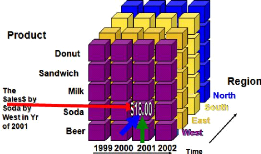
Figure 5.6: Data cube
can see in this figure, we can have many dimensions in the B.I
that are according to the need of the entreprise and this allows for the
entreprise to stay competitive in the market. To build a data cube, firstly we
need to have a knowledge in how to construct an operation data base, the use of
UML8 with all details diagrams and so on. The notion of how to build
a operator database you can read those books [Bar05], [GG08] and for building
the cube you can find more details and understand the notion of measure and
dimension in [KR02]. With a data cube, we can do operations like,zoom up and
zoom down. The B.I have three main steps for the data to be analysed. We will
see it in the next figure and try to explain the functionality of all the part
briefly and for us, will be focus on an element in the B.I architecture not all
elements but just one element where we will try to figure out our assumption
for applying QKD in all DSS like oracle, SQL-Server, PostGre.
In this picture, we can see the full steps follow by datas
before the decider have information which he needs and starts to decide.
8UML : Unifield Modeling language
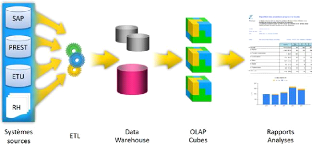
Section 5.2. Databases future work Page 32
Figure 5.7: B.I Architecture
For us, the main thing is to describe the object ETL where we
will study deeply the composition of ETL and try to propose a new application
of QKD in Business Inteligence.
As a definition, ETL (Extract-Transform-Load ) is an
intelligent informatic technology which provide a massive a sychronization of
information from one entite to another. The letter of ETL is define like :
1. Extracts : To extract the data from homogeneous or
heterogeneous data sources
2. Transform : To transform the data for storing it in proper
format or structure for querying and analysis propose.
3. Load : The load is for the final target where the data
must reach its can be a data mark, an operational data store, or a data
warehouse
We know that many structures have a need for security. As we
show it in our thesis, a quantum cryptographic cryptosystem provide an
unconditional security. In our future work, we want to go deeply in this topic
and try to propose a new kind of business intelligence which can be called a
Q.B.I (Quuantum Business Intelligence). The integration of a QKD in the B.I can
be done in ETL because in that element we have three operations which is
Reading, Mapping and Writting.
1
CONCLUSION
The combination of quantum mechanic with cryptography has
given rise to a new field which is quantum cryptography. In this project, we
started by introducing the basic cryptographic notions, namely
encryption/decryption, one type of cryptosystems and Diffie-Hellmann
Key-Exchange.
As this field make a jonction with physics, in our second
part, we studied some notions related to quantum mechanics as polarization,
Heisenberg Uncertainty Principle, quantum entanglement and the no-cloning
theorem where we explained the use of those notions. The notions developed in
the second section of this project, are the basic and important one to
understand physics notions used in quantum cryptography and those notions allow
us to introduce a Quantum Key Distribution Protocols (QKD), QKD as a main
element in quantum cryptography, follow by Quantum Key Distribution
implementation technologies. We also gave some examples and come up with the
last point related to Quantum key Distribution applications.
Indeed, we reach our last point by taking one example of
application SECOQC which is a quantum network. In this application, BBN
Technolgy with Havard University and others groups developed new protocols for
quantum area in the F6 project. The protocols was developped in OSI model,
using the composition of the model, the researchers added a new componant in
the classical protocols acting with specific layers. As in session layer, they
added a QKD in TLS/SSL and the combination give the QSSL protocol again they
added in network layer, they combine two protocols nammed IPSEC plus QKD and
they found a new protocol called SEQKEIP. The last one is data link where they
found other name like Q3P, which is the composition of QKD with a protocol
Point-to-point protocol. This is one of the applications of quantum
cryptography. All the applications and technologies are possible by the way of
single photon and single detector. The only way they are used for transmitting
information through quantum network is an optical fiber.
2
Acknowledgements
I express my sincere thanks to the AIMS-NEI and AIMS-Senegal
family, for funding, providing me with an opportunity to study and all the
necessary facilities for completion of my work in good condition.
I place on record, sincere gratitude to my supervisor Dr.
Kassem Kalach, from Institue for Quantum Computing. I am extremely thankful and
indebted to him for his expertise, sincere and valuable guidance extended to
me.
Big thanks to my father Jean Kanyinda Bidiku and mother Jeanne
Ngomba Bitota for helping and supporting me since i was borned till now. Thanks
to my sisters Lydie Gambwalemba Galubadi-a-Lemba, Fidele Kapinga Kalonji, Ruth
Muambi Kanyinda, Esther Mbombo Kanyinda, Dorcas Ngomba Kanyinda.
I thanks my tutor Miss. Bernadette Faye for her help,
constructive criticism, encouragement and support during my essay phase.
I also thank my colleagues and all tutors, one and all, who
directly or indirectly, have lent their hand in this venture.
3
References
[AD11] Atsushi Yabushita and Department of Electrophy,
Schemes to generate entangled photon
pairs via spontaneous parametric down conversion, May
2011.
[Bar05] Franck Barbier, UML 2 et MDE: ingnierie des modles
avec tudes de cas, Dunod, Paris, 2005
(French).
[BHL07] Paul Busch, Teiko Heinonen, and Pekka Lahti,
Heisenberg's uncertainty principle, Physics
Reports 452 (2007), no. 6, 155-176.
[EAA] Mohamed Elboukhari, Abdelmalek Azizi, and Mostafa Azizi,
Integration of Quantum Cryp-
tography in the TLS Protocol: Reality and
Perspectives, MICS 10, 2-4.
[GG08] Joseph Gabay and David Gabay, UML 2 analyse et
conception: mise en oeuvre guide avec
tudes de cas, 2008.
[Hai14] Mart Haitjema, A survey of the prominent quantum key
distribution protocols, URL:
http://www. cse. wustl. edu/ jain/cse571-07/ftp/quantum ( 18.10.
2013), 2014.
[KDB+] E. Karpov, T. Durt, F. Vanden Berge, N. J.
Cerf, and T. dHondt, Cryptographie quantique,
White paper, 10.
[KR02] Ralph Kimball and Margy Ross, The data warehouse
toolkit: the complete guide to dimen-
sional modeling, 2nd ed ed., Wiley, New York, 2002.
[KX] Muhammad Mubashir Khan and Jie Xu, Applications of QKD
Network for High Performance
Distributed Computing.
[Mer07] N. David Mermin, Quantum computer science an
introduction, Cambridge University Press,
Cambridge, 2007 (English).
[MVOV96] Alfred J. Menezes, Paul C. Van Oorschot, and Scott A.
Vanstone, Handbook of applied cryptography, CRC press, 1996.
[NAZ02] Olaf Nairz, Markus Arndt, and Anton Zeilinger,
Experimental verification of the Heisenberg uncertainty principle for
fullerene molecules, Physical Review A 65 (2002), no. 3
(en).
[NC10] Michael A. Nielsen and Isaac L. Chuang, Quantum
computation and quantum information,
10th anniversary ed ed., Cambridge University Press, Cambridge ;
New York, 2010.
[QQL10a] Bing Qi, Li Qian, and Hoi-Kwong Lo, A brief
introduction of quantum cryptography for engineers, arXiv preprint
arXiv:1002.1237 (2010).
[QQL10b] , A brief introduction of quantum cryptography for
engineers, arXiv preprint
arXiv:1002.1237 (2010).
[Sar] Debasis Sarkar, Quantum Entanglement- Fundamental
Aspects.
[Sar14] Mohan Sarovar, Introduction to quantum key
distribution, October 2014.
[Sca09] Valerio Scarani, Quantum information: primitive
notions and quantum correlations, arXiv
preprint arXiv:0910.4222 (2009).
REFERENCES Page 4
[SML10] Douglas Stebila, Michele Mosca, and Norbert Ltkenhaus,
The case for quantum key distri-
bution, Quantum Communication and Quantum Networking,
Springer, 2010, pp. 283-296.
[SRS12] Peter Schartner, Stefan Rass, and Martin Schaffer,
Quantum Key Management, APPLIED
CRYPTOGRAPHY AND NETWORK SECURITY, 2012, p. 227.
[SSL09] Douglas Stebila, Douglas Stebila, and Norbert Ltkenhaus,
The Case for Quantum Key
Distribution, 12.
[STH] M. A. Sfaxi, I. Tashi, and S. Ghernaouti Hlie, How QKD
can improve the security level of
future e-commerce transaction, Proc. 18th European
Regional International Telecommunication Society Conf.(ITS2007), Citeseer, pp.
1-12.
[STI06] Douglas R. STINSON, Cryptography theory and practice
third edition, chapman & Hall
/CRC, Taylor & Francis Group, 2006 (English).
[Tan13] Xiaoqing Tan, Introduction to Quantum
Cryptography, Theory and Practice of Cryptography
and Network Security Protocols and Technologies (Jaydip Sen,
ed.), InTech, July 2013, p. 1 (en).
[VA06a] Gilles Van Assche, Quantum cryptography and
secret-key distillation, Cambridge University
Press, Cambridge ; New York, 2006.
[VA06b] , Quantum cryptography and secret-key
distillation, Cambridge University Press,
2006.
[Zha09] Yi Zhao, Quantum cryptography in real-life
applications: assumptions and security, Ph.D.
thesis, University of Toronto, 2009.
| 


